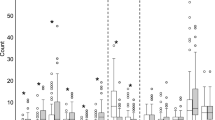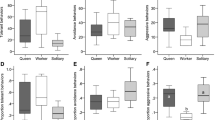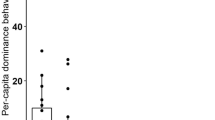Summary
-
1.
A new method of observation is used to assay the behavior of three groups of individuals from colonies ofLasioglossum zephyrum (Hymenoptera: Halictidae). These groups (queens, guards, and foragers) differ significantly in several behavioral attributes. Guards were never observed to pass non-nestmate guards, a common interaction among nestmates. Foragers and queens pass frequently. Guards elicit submissive behavior from foragers more frequently than foragers elicit submissive behavior in guards.
-
2.
Queens are significantly larger in two body size measurements than guards, and guards are significantly larger than foragers. Queens have the largest ovaries, guards the second largest, and foragers the smallest, on the average.
-
3.
A relationship between ovarian development and dominance behavior is suggested but not conclusively demonstrated.
-
4.
Young (1 day old) bees with no social experience engage in normal social interactions, including passing, but older (5 day old) inexperienced bees do not pass; there is apparently a critical period in the behavioral development of individuals after which the cannot engage in normal social interactions.
-
5.
In encounters between members of different groups individuals can rapidly assess the status of the individual which they are encountering and display the appropriate behavioral response.
Zusammenfassung
-
1.
Eine neue Beobachtungsmethode wird verwendet, um das Verhalten vonLasioglossum zephyrum (Hymenoptera: Halictidae) zu analysieren. Drei Gruppen werden dabei untersucht: Königinnen, Wächter und Sammelbienen. Diese Gruppen zeigen wesentliche Unterschiede in einigen Verhaltensmerkmalen. Es wurde nie beobachtet, dass Wächter eines Volkes die eines anderen Volkes passierten, was ein gewöhnliches Verhalten für Bienen von selben Volke ist. Sammelbienen und Königinnen dagegen passieren häufig. Wächter rufen in Sammelbienen öfter unterwürfiges Verhalten hervor als umgekehrt.
-
2.
Königinnen sind in zwei Körpermessungen wesentlich grösser als Wächter, und Wächter wesentlich grösser als Sammelbienen. Im Durchschnitt haben Königinnen den grössten Eierstock, Wächter den zweitgrössten und Sammelbienen den Kleinsten.
-
3.
Eine Beziehung zwischen Eierstockentwicklung und dominantem Verhalten kann angenommen, aber nicht schlüssig bewiesen werden.
-
4.
Junge, einen Tag alte Bienen mit noch keinerlei sozialer Erfahrung zeigen normales soziales Verhalten und passieren andere Bienen, was fünf Tage alte, un erfahrene Bienen dagegen nicht tun. Es gibt offensichtlich eine kritische Periode in der Varhaltensentwicklung der Einzeltiere, nach der sie kein normales Verhalten zeigen können.
-
5.
Treffen Mitglieder verschiedener Gruppen aufeinander, so können Einzeltiere schnell den Status ihres Gegenübers einschätzen und die angemessene Verhaltensreation zeigen.
Similar content being viewed by others
Literature Cited
Barrows (E. M.), Bell (W. J.) andMichener (C. D.), 1975. — Individual odor differences and their social functions in insects.Proc. Nat. Acad. Sci. (U.S.A.),72, 2824–2828.
Batra (S. W. T.), 1966. — The life cycle and behavior of the primitively social bee,Lasioglossum zephyrum (Halictidae).Univ. Kansas Sci. Bull., 46, 359–423.
Bell (W. J.), 1974. — Recognition of resident and non-resident individuals in intraspecific nest defense of a primitively eusocial halictine bee.J. Comp. Physiol., 93, 173–181.
Bell (W. J.), Breed (M.), Richards (K. W.) andMichener (C. D.), 1974. — Social stimulatory and motivation factors involved in intraspecific nest defense of a primitively eusocial halictine bee.J. Comp. Physiol., 93, 173–181.
Bell (W. J.) andHawkins (W. A.), 1974. — Patterns of intraspecific agonistic interactions involved in nest defense of a primitively eusocial halictine bee.J. Comp. Physiol., 93, 183–193.
Breed (M. D.), 1977. — Interactions among individuals and queen replacement in a eusocial halictine bee.Proc. VIIIth Congress Int. Union for the Study of Social Insects, Wageningen, 228–231.
Breed (M. D.) andGamboa (G. J.), 1977. — Control of worker activities by queen behavior in a primitively eusocial bee.Science, 195, 694–696.
Brothers (D. J.), 1972. — Biology and immature states ofPseudomethoca f. frigida, with notes of other species (Hymenoptera: Mutillidae).Univ. Kansas Sci. Bull., 50, 1–38.
Brothers (D. J.) andMichener (C. D.), 1974. — Interaction in colonies of primitively social bees III. Ethometry of division of labor inLasioglossum zephyrum (Hymenoptera: Halictidae).J. Comp. Physiol., 90, 129–168.
Deleurance (E. P.), 1950. — Sur le mécanisme de la monogynie factionnelle chez lesPolistes.C. R. Acad. Sci., Paris., 230, 782–784.
Jeanne (R. L.), 1972. — Social biology of the Neotropical wasp,Mischocyttarus drewsenii.Bull., Mus. Comp. Zool., Harvard Univ., 144, 63–150.
Kukuk (P. F.), Breed (M. D.), Sobti (A.) andBell (W. J.), 1977. — The contributions of kinship and conditioning to nest recognition and colony member recognition in a primitively eusocial bee,Lasioglossum zephyrum (Hymenoptera: Halictidae).Behav. Ecol. Sociobiol., 2, 319–327.
Kumar (S.), 1975. — Relations among bee size, cell size, and caste, inLasioglossum zephyrum (Hymenoptera: Halictidae).J. Kansas Entomol. Soc., 48, 374–380.
Michener (C. D.), 1974. — The social behavior of the bees.Harvard Univ. Press, Cambridge, Mass.—Michener (C. D.), 1977. Caste evolution in primifively social insects.Proc. VIIIth Congress Int. Union for the Study of Social Insects, Wageningen., 2–6.
Michener (C. D.) andBrothers (D. J.), 1974. — Were workers of cusocial Hymenoptera initially altruistic or oppressed?Proc. Nat. Acad. Sci., 71, 671–674.
Michener (C. D.) andWille (A.), 1961. — The bionomics of a primitively social bee,Lasioglossum inconspicum.Univ. Kansas Sci. Bull., 42, 1123–1202.
Pardi (L.), 1948. — Dominance order inPolistes waspsPhysiol. Zool., 21, 1–13.
Sokal (R. R.) andRohlf (F. J.), 1969. — Biometry.S. H. Freeman and Company, San Francisco, 777 p.
West Eberhard (M. J.), 1969. — The social biology of polistine wasps.Univ. Michigan Mus. Zool. Misc. Publ., 140, 1–101.
Wilson (E. O.), 1953. — The origin and evolution of polymorphism in ants.Q. Rev. Biol., 28, 136–156.—Wilson (E. O.), 1971. The insect societies.Harvard Univ. Press, Cambridge, Mass.
Author information
Authors and Affiliations
Rights and permissions
About this article
Cite this article
Breed, M.D., Silverman, J.M. & Bell, W.J. Agonistic behavior, social interactions, and behavioral specialization in a primitively eusocial bee. Ins. Soc 25, 351–364 (1978). https://doi.org/10.1007/BF02224299
Received:
Accepted:
Issue Date:
DOI: https://doi.org/10.1007/BF02224299




